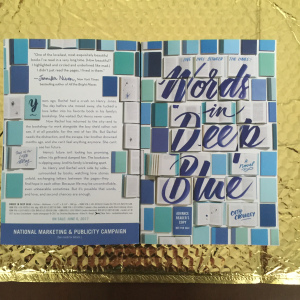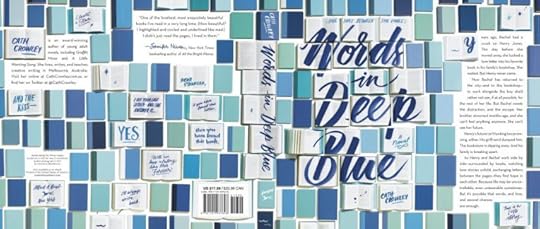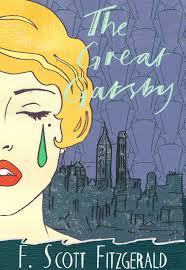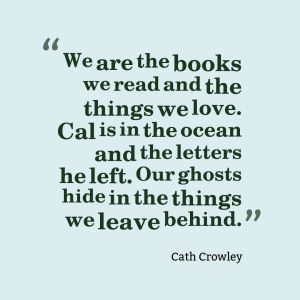Cath Crowley's Blog
December 14, 2016
The Letter Library
The wonderful Pan Macmillan has created a virtual Letter Library, inspired by Words in Deep Blue.
I’d love it if people submitted to the library. All the instructions are on the site. You can post quotes from Words in Deep Blue, letters you might write to strangers, notes you would scrawl in margins on the books that you love.
I’ll be a regular poster. I hope to see you there.
Cath x
[image error]


November 28, 2016
Words to Make Poetry
For Teachers
Some of the wonderful teachers that I’ve worked with over the last year have asked me for a copy of the words that I use in one of my workshop activities, so I thought I’d post them here. You can use any words, just make sure there’s a mix of verbs and nouns. I make sure there are some words that students might not know – it means that there’s some conversation about word definitions.
I do this activity to warm up the group before we do a larger writing activity. It helps with playfulness, it reminds us of words we love, it makes us think of the possibilities that exist with words – makes us realise that one word can change another. And it extends vocabulary.
I’ve run the activity all over Australia and it has never failed. There’s no pressure. People like to play with language. They like to play. And, to be honest, some students think they’re getting out of work, so they’re happy to go along. It doesn’t matter why they participate – we don’t spend enough time thinking about words.
Lastly, if you’re running a workshop, it’s great for group dynamics.
So. The activity. You’ll run it better than I do, I’m sure, but in case it helps, here’s how I do it.
Print off sets of words, cut them up and put one set into an envelope to make a word packet. It’s great if you laminate them, that way you don’t lose words.
Put students into groups. It works in groups of anything up to six.
Before you hand out the envelopes, tell students –
Their group will get an envelope with words in them
They’ll have six minutes *
When the timer starts, they’ll empty the words onto the table, turn them all over, and start making interesting word combinations.
The aim of the activity is to make interesting word combinations. They can combine two words, three words, anything they like.**
Empty your word packet onto the desk as an example, and combine some words to give them examples – monstrous neighbours, shallow sky, stuttering heart, picket teeth.
Have the group nominate one or two scribes. The whole thing is play, so it has to feel like play, so if they don’t keep a physical copy of their words on the way through, it doesn’t matter. They could just keep the words combinations on the desk so they can see them.
After they start, walk around and listen for great combinations and put some on the board.
When the time is up – and I always extend it – have groups share their favourite combinations.
I always finish by chatting about how important it is to work with words, to remind ourselves of their possibilities. I remind them that they shouldn’t use a hundred of these combinations in their next writing piece – but one can make a paragraph crack. ‘Growing up we had monstrous neighbours’.
* I start with six minutes but people usually want more time, so I extend it.
**It doesn’t matter if the students just look at the words. I once had a class where a group wanted to set out all their favourite words and talk about them. This is great. It’s amazing. Some groups I’ve had have made table long poems. Mostly, students combine two words to make interesting descriptions. It doesn’t matter if some combinations make no sense. Just let it go. The point is to play.
If you’re short on time
I put up a chart of words on a PowerPoint and skip the word packets. It still works. Although, not always as well. It depends on the dynamics of the class.
For Writers
I do this word activity at the start of a writing day or week – it reminds me that I love words – reminds me that writing doesn’t always have to be difficult.
with love,
Cath


November 16, 2016
words from words in deep blue
November 13, 2016
Using sticky notes as a resource in the classroom
I love the post it notes on New York subway – they remind me that there are a lot of people that want the same things that I do – want the environment protected, want everyone’s civil rights protected, healthcare protected, asylum seekers protected.
You can see some great pictures of them at The Guardian – Post-its on New York subway provide post-election therapy – in pictures
It made me think about how great this would be to use in the classroom. Also, how great index cards and sticky notes are in general.
After studying a topic, in any subject, every class member has to place a note on a wall at the back with one fact or thought about it. It’s a great way to make the task one that gets everyone involved.
Obviously great for students to post about their feelings on an issue, a novel. Great way for students to pull out key quotes from novels. And it works because it looks good, it has a context (you could show them the photos), it’s a class project.
I love the idea of students reading Words in Deep Blue – or any book, actually – and putting post it notes into books around the library. Small notes about the things they love. Small notes about the importance of quotes. Small notes about sentences that work, and why they work, and what this book made them feel.
In English, which is the one I’m most excited about – it’s a variation on the index card plotting idea. A wall at the back of the class that allowed students to post their paragraph topics on it to plan an imaginative essay, or a personal one, or any essay really, would have made things so much easier for a planner like myself.
If a student is stuck, have them write possible topic sentences, go to the back wall, and arrange their five notes in a way that looks like it might work. Scrivener in the classroom, sort of. But physical. A reminder that most people find plotting difficult, but there are practical strategies that help. Plotting is not impossible. It takes a basic knowledge of structure and a way of visualising that structure.


November 8, 2016
Creative Writing Day Retreat Bunninyong 3 December
October 13, 2016
Creative Writing Day Retreat
October 6, 2016
October News
The US ARCS for Words in Deep Blue arrived, looking very beautiful.


Hung out with the brilliant Sally Rippon and Kulja Coulston on The Reading Room, part of The Grapevine at RRR.
Also spoke to the wonderful people who present the OZYA Extra program on the ABC – Rhianna Patrick, Jeann Wong and Miffy Farquharson. You can listen to the discussion on the ABC website
Other ABC programs about Words in Deep Blue – BooksPlus with Kate Evans. Love Kate’s program – whether I’m on it or not. Love too Books and Art
Also, lucky enough to be on the fabulous Bookish Friends podcast.


September 17, 2016
US Cover Reveal – Words in Deep Blue
The gorgeous cover for The US release of Words in Deep Blue. Many, many thanks to everyone at Knopf for all the hard work on this one. Special thanks to Allison Wortche.
“One of the loveliest, most exquisitely beautiful books I’ve read in a very long time. . . . I didn’t just read the pages, I lived in them.” —Jennifer Niven, New York Times bestselling author of All the Bright Places
A beautiful love story for fans of Jandy Nelson and Nicola Yoon: two teens find their way back to each other in a bookstore full of secrets and crushes, grief and hope—and letters hidden between the pages.
Years ago, Rachel had a crush on Henry Jones. The day before she moved away, she tucked a love letter into his favorite book in his family’s bookshop. She waited. But Henry never came.
Now Rachel has returned to the city—and to the bookshop—to work alongside the boy she’d rather not see, if at all possible, for the rest of her life. But Rachel needs the distraction. Her brother drowned months ago, and she can’t feel anything anymore.
As Henry and Rachel work side by side—surrounded by books, watching love stories unfold, exchanging letters between the pages—they find hope in each other. Because life may be uncontrollable, even unbearable sometimes. But it’s possible that words, and love, and second chances are enough.




September 15, 2016
The Letter Library.
Write a letter. Leave it in a book.
...
Write a letter. Leave it in a book.

Over on tumblr, over here, you’ll find a virtual Letter Library. Write a margin note, write a letter – to a stranger, a friend, a word, an author – leave it in a book. Send submissions to me via facebook, twitter or tumblr.














